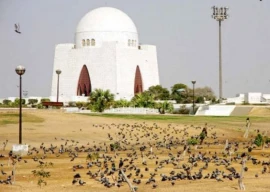
After thousands of years swimming the mighty river the gentle, blind mammal is under threat from a combination of uncontrolled fishing and damage to its habitat caused by man-made dams.
Conservationists are fighting to save the dolphin as well as the river's black spotted turtle, at risk from poachers who hunt it to sell to collectors and traditional medicine dealers.
The dolphin, which can grow up to 2.5 metres, is one of the world's rarest mammals, with a population of just 1,400 living scattered along a 1,200-kilometre stretch of the Indus, which rises in the Himalayas and flows out into the Arabian Sea near Karachi.
They are classed as endangered on the International Union for Conservation of Nature (IUCN) red list of threatened species, which says the population has fallen by more than 50 percent since 1944. Functionally blind, they use echolocation - a form of natural sonar - to find fish, shrimp and other prey in the muddy river waters.
Sticking their snouts and heads from the waters, the dolphins bring serenity to the river in the shadow of the Sukkur Barrage, built by the British, around 470 kilometres north of Karachi.
The monsoon season draws families and picnickers hoping to catch a glimpse of the dolphins.
But the series of dams and barrages built across the Indus since the late 19th century to help irrigate farmland have divided the dolphin's habitat into 17 separate sections.
The dolphin has died out in 10 of these sections, according to a recent study published in the PLoS One journal by experts from Britain's St Andrews University, and the sub-populations are left more vulnerable by their isolation.
When the river recedes after the heavy rains of the monsoon, the dolphins can become stranded in isolated ponds and tributaries, starving them of food and making them vulnerable to predators.
Another threat to the dolphin, whose pinkish-grey skin breaks the surface of the turbid waters as it comes up to breathe, comes from fishing.
"Narrow fishing nets trap the dolphin under the water and she needs to come out to breathe after every one to two minutes," Muhammad Imran Malik, from the dolphin protection project of World Wildlife Fund (WWF) told AFP on the riverbank in the town of Sukkur.
The WWF has set up a network of fishing communities on both banks of the river and the link canals to keep vigil on any trapped dolphin and report it to conservators.
"We have different awareness activities among local fishermen, communities and other people about the dolphins' habitat, threats and the importance of its existence in the river," Malik told AFP.
Fisherman Gajan Khan Malah is one of the WWF volunteers who plays a role in monitoring the dolphins.
"Some years ago we saw a dolphin stranded in shallow waters, while we were fishing," Malah said.
"We called the WWF officials and they came instantly to rescue her and we netted the dolphin and handed her to them. They released it in the river," he added proudly.
As the WWF and other Pakistani agencies strive to save the dolphin, a new threat to the Indus ecosystem has emerged: smugglers hunting black pond turtles, also known as black spotte turtles, to sell them illegally to clients in China and Thailand.
"There is a market for every species, and this is a very unique turtle. It has a black colour with white and yellow spots, which is fascinating for many turtle lovers who keep them as pets," said Uzma Noureen, the WWF project coordinator at a sanctuary for rescued turtles.
Around 200 turtles, which are listed as vulnerable on the IUCN list, were smuggled from Pakistan to Taxkorgan in China's Xinjiang autonomous region in June.
Pakistan officials travelled by road to bring the turtles back home to the sanctuary in Sukkur, where they were held in a makeshift quarantine.
"It is like we rescued a ship from the clutches of pirates. We are now releasing them into their natural habitat and it is a great accomplishment for me and my whole team," said Javed Mahar, chief of Sindh Wildlife Department, as the turtles were slipped into a tributary of River Indus.
Pakistani customs authorities recently recovered at least two consignments of hundreds of protected turtles, which were being smuggled abroad from Karachi airport.
"There is an alarming rise in smuggling cases of the black spotted turtles because of the lucrative market in countries like Thailand and China," said Ghulam Qadir Shah, researcher at IUCN.
A turtle can fetch $1,600 overseas with prices kept high by both passionate turtle enthusiasts looking for pets and others who want to consume the flesh or use the species for traditional medicine purposes.
Shah stressed the need for regional coordination to protect the turtles. "We are planning with other departments and wild life protectors to stop the smuggling of this beautiful creature".
COMMENTS (2)
Comments are moderated and generally will be posted if they are on-topic and not abusive.
For more information, please see our Comments FAQ
1731570357-0/elon-musk-(1)1731570357-0-405x300.webp)
-(1)1717678110-0/Kendrick-(1)-(1)1717678110-0-165x106.webp)



1732428532-0/BeFunk_§_]__-(43)1732428532-0.jpg)




1725254039-0/Untitled-design-(24)1725254039-0-270x192.webp)






What hope for the preservation of Allahs nature when in Pakistan human life has no life has no VALUE.
Whole world is concerned and working together with Geographic Information System (GIS) and Remote Sensing Experts to map and monitor all the endangered species and trying to enforce certain laws that make sure that habitat of these species are persevered.
Pakistan specifically is lagging in this field. Efforts of WWF Pakistan and other Non-governmental organizations are really appreciable but still a lot needs to be done. Students from different fields like Environmental Sciences and Wild Life studies needs to be trained using GIS and Remote Sensing Techniques and apply them to the benefit of these species.
After previously reading an article about turtles and how badly their habitat has been affected on the Coasts of Pakistan. I was personally part of one study that was conducted in a Swedish University. The study was emphasized on some bird species that are on the verge of being considered endangered in Sweden. Geo-Statistical techniques like Logistic regression was used to model the habitat of that bird species and habitat suitability maps were developed and later presented to Environmentalist in certain conferences to enforce laws to preserve the endangered species and their habitats.
In the recent years Swedish gone has gone further to install Cameras near to nests of some birds to monitor their daily movement. Crowd-Source Data collection websites are already there, where volunteers report any citing of bird species. All that volunteered submitted data is cleaned on national level and steps are being taken to use this data for Scientific studies.
Pakistan needs to learn from such initiatives and hopefully in the coming years we will be able to use these advanced techniques to monitor our endangered species too.